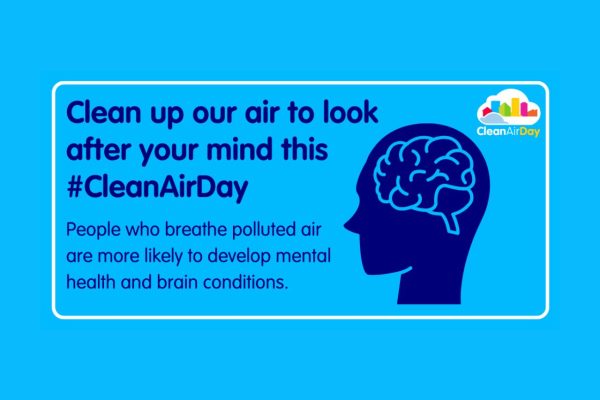We recognise that some people are considering switching to log burners as an alternative to gas when heating their homes. Although energy prices are increasing, we cannot recommend this as a healthy or environmentally-friendly solution, nor a cheaper way to heat your home. Global Action Plan’s recent research, ‘Relight my fire? Investigating the true cost of wood burning stoves’ reveals that in most circumstances, wood burning is more expensive than gas central heating or heat pumps.
With so much new information available about the impacts of wood burning, not just to our wallets but our health as well, we took to the streets to find out what residents think. Here’s what happened ⬇️
Inspired to find out more? We’d love to help you find cleaner, more sustainable ways of keeping warm at home. Just drop us an email at cleanair@environmentcentre.com or call us on 0800 804 8601.



Health problems caused by wood smoke has been the topic of extensive research in recent years but sadly, few people understand the extent of the issue.
Wood smoke has been directly linked to illnesses including asthma, dementia, stroke and some cancers.
Professor Stephen Holgate has carried out extensive research in the subject and says: “Particulate air pollution is the most harmful type of air pollution to humans. If you have alternative heating systems, you and your family will be breathing cleaner air.”
Watch our short animation; ‘The Hidden Harms of Wood Smoke‘ and share the video on your social media platforms.
Wood smoke causes big problems for the planet as well as ourselves. Every time we light a fire, we’re releasing harmful gases including carbon monoxide, benzene and formaldehyde into the environment, as well as soot and dirt (particulate matter).
Burning wood also produces carbon dioxide (CO2), a greenhouse gas that contributes to climate change. Burning wood actually releases more carbon dioxide than oil or gas for the same amount of heat or energy.
1. Humans have been burning wood for thousands of years. How bad can it be?!
There is new and mounting evidence that shows wood burning harms your wallet, your health and the planet. Lighting fires in our homes is the single biggest source of harmful small particle air pollution in the UK. Burning wood accounts for 75% of these emissions.
2. What about other sources of air pollution in the area?
Over the past ten years, the amount of harmful small particle air pollution caused by domestic burnings has more than doubled – whilst the pollution caused by industry, cars, vans and lorries is decreasing.
3. I have an ‘eco-design’ stove; is that better?
Even homes with the newest ‘eco-design’ wood burners are three times more polluted than those without. The ‘eco-design’ labels on stoves is unfortunately misleading consumers to believe that burning wood in these stoves doesn’t produce pollution or harm the environment. Eco-design wood burning stoves produce 450 times more toxic air pollution than gas central heating.
4. Isn’t burning wood better than burning fossil fuels?
For the same amount of heat or energy, burning wood releases more carbon dioxide than oil or gas. Cutting down trees destroys forests, damages eco-systems and leads to biodiversity loss.
5. Burning wood is cheaper than using my central heating though, isn’t it?
Wood burners are almost always more expensive to heat your home than gas boilers or heat pumps. The exception is if you have your own wood supply – but then the wood must be dried properly, for at least two years.
6. I’ve used a log burner/open fire for years and I’m fine. What’s all the fuss about?
There is new and mounting evidence that shows wood burning harms your wallet, your health and the planet. Air pollution is the biggest environmental threat to our health.
7. Aren’t open fires the problem, not stoves?
While open fires are the most polluting way to heat your home, even homes with the newest eco design wood burners have three times more indoor air pollution than homes without. Almost twice as many people who burn indoors use a stove rather than an open fire.
8. I rely on wood heating as my only source of heat. What can I do?
It is important for everyone to be warm and well at home. We may be able to help you access funding for a cleaner, greener heating system. Please call us on 0800 804 8601 if you’d like to find out more.
9. Is it true that wood burning is a carbon neutral means of home heating?
Not in most cases. It takes many years to produce wool for fuel which is burnt in a matter of minutes. Burning wood actually releases more carbon dioxide than oil or gas for the same amount of heat or energy.
10. I always use dry wood; is that OK?
Burning well-seasoned wood will reduce the amount of pollutants produced to a quarter of the pollution of wet wood, but it is still highly polluting compared to other heat sources.
11. Wood smoke is natural and therefore harmless, isn’t it?
When wood is burnt it releases a number of toxic chemicals, including Benzene, Toulene, Formaldehyde, arsenic and carbon monoxide.
References
Emissions of air pollutants in the UK (Gov.uk)
Chief Medical Officer’s annual report 2022: air pollution (Gov.uk)
Range and uncertainties in estimating delays in greenhouse gas mitigation potential of forest bioenergy sourced from Canadian forests (Wiley Online Library)
A stand of trees does not a forest make (Science Direct)
Wood burning is more expensive than central heating (Impact on Urban Health)
Burning in UK homes and gardens (Kantar research)
Relight my fire? Investigating the true cost of wood burning stoves. Published by Global Action Plan, April 2023
Clean Air Day 2023 resource sheet, June 2023
An interview with Professor Stephen Holgate, filmed March 2023:
Log burner rule change in England could land users with £300 fines, BBC, Feb 2023
Mums for Lungs calls on the Government to act, Jan 2023
My burning shame, by George Monbiot, The Guardian, Dec 2022
Wood burners emit more particle pollution than traffic, The Guardian, Feb 2022
Now that you’re aware of the harms caused by burning wood, we invite you to join our campaign to improve air quality.
The most helpful thing that you, your friends, family and neighbours can do, is simply avoid burning wood – both indoors using wood stoves and log burners, and outdoors with bonfires.
It can sometimes be tricky to start a conversation with someone who loves their log burner! Here are some tips for starting a healthy discussion.
- Remember that some people bought their log burner with genuine intentions. Some log burners are marketed as eco-friendly and some people have no other way to keep their homes warm.
- Understand that behaviour change takes time, so short and regular conversations will potentially be more effective than a one-off chat.
- Give them our contact details! We’re here to help Southampton, Hampshire and Portsmouth residents find efficient, affordable and environmentally-friendly home heating solutions.
You’re very welcome to make use of our social media assets, leaflets and posters to help get your own conversations started.
Social media assets
What if wood burning is my main source of heat?
It may be possible to switch from wood burning to a cleaner and greener heating system. Contact us for help and advice on 0800 804 8601
Is wood burning low carbon?
In most cases wood burning is not low carbon. It takes a long time for trees to re-grow and re-capture the carbon that is released during burning.
How is wood smoke harmful?
Woodsmoke contains millions of tiny invisible particles of soot. These particles can get deep into our lungs and pass into our bloodstream, travelling around the body causing damage.
Leaflets and posters
Thinking of having a bonfire? (A5 leaflet)
Thinking of having a bonfire? (A5 leaflet print-ready artwork)
Thinking of having a bonfire? (A4 poster)
Thinking of having a bonfire? (A4 poster print-ready artwork)
Do you burn wood to keep warm? (A5 leaflet)
Do you burn wood to keep warm? (A5 leaflet print-ready artwork)
Do you burn wood to keep warm? (A4 poster)
Do you burn wood to keep warm (A4 poster print-ready artwork)
Do you burn wood in your home? (A5 leaflet)
Do you burn wood in your home? (A5 leaflet print-ready artwork)
Do you burn wood in your home? (A4 poster)
Do you burn wood in your home? (A4 poster print-ready artwork)



